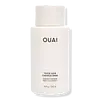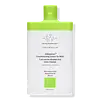What's inside
What's inside
 Key Ingredients
Key Ingredients

 Benefits
Benefits

 Concerns
Concerns

 Ingredients Side-by-side
Ingredients Side-by-side

Water
Skin ConditioningCetearyl Alcohol
EmollientBehentrimonium Chloride
PreservativeParfum
MaskingCetrimonium Chloride
AntimicrobialPanthenol
Skin ConditioningHydrolyzed Keratin
HumectantPersea Gratissima Oil
Skin ConditioningAlthaea Officinalis Root Extract
Skin ConditioningDimethicone
EmollientAmodimethicone
Butyrospermum Parkii Butter
Skin ConditioningPolyquaternium-37
Dicaprylyl Carbonate
EmollientLauryl Glucoside
CleansingDivinyldimethicone/Dimethicone Copolymer
C11-15 Pareth-7
EmulsifyingLaureth-9
EmulsifyingGlycerin
HumectantTrideceth-12
EmulsifyingC12-13 Pareth-23
CleansingC12-13 Pareth-3
EmulsifyingDimethiconol
EmollientPropoxytetramethyl Piperidinyl Dimethicone
Trideceth-6
EmulsifyingEthylhexylglycerin
Skin ConditioningTocopherol
AntioxidantIsopropyl Alcohol
SolventGuar Hydroxypropyltrimonium Chloride
Skin ConditioningCitric Acid
BufferingSodium Chloride
MaskingSorbitan Oleate
EmulsifyingSodium Hydroxide
BufferingAcetic Acid
BufferingSodium Acetate
BufferingPhenoxyethanol
PreservativePotassium Sorbate
PreservativeBenzyl Salicylate
PerfumingLimonene
PerfumingHexyl Cinnamal
PerfumingWater, Cetearyl Alcohol, Behentrimonium Chloride, Parfum, Cetrimonium Chloride, Panthenol, Hydrolyzed Keratin, Persea Gratissima Oil, Althaea Officinalis Root Extract, Dimethicone, Amodimethicone, Butyrospermum Parkii Butter, Polyquaternium-37, Dicaprylyl Carbonate, Lauryl Glucoside, Divinyldimethicone/Dimethicone Copolymer, C11-15 Pareth-7, Laureth-9, Glycerin, Trideceth-12, C12-13 Pareth-23, C12-13 Pareth-3, Dimethiconol, Propoxytetramethyl Piperidinyl Dimethicone, Trideceth-6, Ethylhexylglycerin, Tocopherol, Isopropyl Alcohol, Guar Hydroxypropyltrimonium Chloride, Citric Acid, Sodium Chloride, Sorbitan Oleate, Sodium Hydroxide, Acetic Acid, Sodium Acetate, Phenoxyethanol, Potassium Sorbate, Benzyl Salicylate, Limonene, Hexyl Cinnamal
Water
Skin ConditioningGlycerin
HumectantCetearyl Alcohol
EmollientCaprylic/Capric Triglyceride
MaskingArgania Spinosa Kernel Oil
EmollientSclerocarya Birrea Seed Oil
HumectantCrambe Abyssinica Seed Oil
Skin ConditioningStearamidopropyl Dimethylamine
EmulsifyingSodium PCA
HumectantBehentrimonium Methosulfate
Hydrolyzed Silk
HumectantSilk Amino Acids
HumectantPseudozyma Epicola/Camellia Sinensis Seed Oil Ferment Extract Filtrate
HumectantSericin
Skin ConditioningPanthenol
Skin ConditioningHydrolyzed Quinoa
Skin ConditioningDicaprylyl Carbonate
EmollientSodium Lactate
BufferingPCA
HumectantAlanine
MaskingArginine
MaskingGlycine
BufferingHistidine
HumectantIsoleucine
Skin ConditioningPhenylalanine
MaskingProline
Skin ConditioningSerine
MaskingThreonine
Valine
MaskingHydroxyethylcellulose
Emulsion StabilisingAspartic Acid
MaskingGlycine Soja Oil
EmollientSorbitan Oleate
EmulsifyingSodium Phosphate
BufferingTocopherol
AntioxidantLauryl Glucoside
CleansingVanilla Planifolia Fruit Extract
Skin ConditioningDisodium Phosphate
BufferingCitric Acid
BufferingPolyquaternium-37
Acrylates/Stearyl Methacrylate Copolymer
Emulsion StabilisingCaprylyl Glycol
EmollientChlorphenesin
AntimicrobialSodium Benzoate
MaskingPhenoxyethanol
PreservativePotassium Sorbate
PreservativeBenzyl Alcohol
PerfumingWater, Glycerin, Cetearyl Alcohol, Caprylic/Capric Triglyceride, Argania Spinosa Kernel Oil, Sclerocarya Birrea Seed Oil, Crambe Abyssinica Seed Oil, Stearamidopropyl Dimethylamine, Sodium PCA, Behentrimonium Methosulfate, Hydrolyzed Silk, Silk Amino Acids, Pseudozyma Epicola/Camellia Sinensis Seed Oil Ferment Extract Filtrate, Sericin, Panthenol, Hydrolyzed Quinoa, Dicaprylyl Carbonate, Sodium Lactate, PCA, Alanine, Arginine, Glycine, Histidine, Isoleucine, Phenylalanine, Proline, Serine, Threonine, Valine, Hydroxyethylcellulose, Aspartic Acid, Glycine Soja Oil, Sorbitan Oleate, Sodium Phosphate, Tocopherol, Lauryl Glucoside, Vanilla Planifolia Fruit Extract, Disodium Phosphate, Citric Acid, Polyquaternium-37, Acrylates/Stearyl Methacrylate Copolymer, Caprylyl Glycol, Chlorphenesin, Sodium Benzoate, Phenoxyethanol, Potassium Sorbate, Benzyl Alcohol
Ingredients Explained
These ingredients are found in both products.
Ingredients higher up in an ingredient list are typically present in a larger amount.
Cetearyl alcohol is a mixture of two fatty alcohols: cetyl alcohol and stearyl alcohol. It is mainly used as an emulsifier. Emulsifiers help prevent the separation of oils and products. Due to its composition, it can also be used to thicken a product or help create foam.
Cetearyl alcohol is an emollient. Emollients help soothe and hydrate the skin by trapping moisture.
Studies show Cetearyl alcohol is non-toxic and non-irritating. The FDA allows products labeled "alcohol-free" to have fatty alcohols.
This ingredient is usually derived from plant oils such as palm, vegetable, or coconut oils. There is debate on whether this ingredient will cause acne.
Due to the fatty acid base, this ingredient may not be Malassezia folliculitis safe.
Learn more about Cetearyl AlcoholCitric Acid is an alpha hydroxy acid (AHA) naturally found in citrus fruits like oranges, lemons, and limes.
Like other AHAs, citric acid can exfoliate skin by breaking down the bonds that hold dead skin cells together. This helps reveal smoother and brighter skin underneath.
However, this exfoliating effect only happens at high concentrations (20%) which can be hard to find in cosmetic products.
Due to this, citric acid is usually included in small amounts as a pH adjuster. This helps keep products slightly more acidic and compatible with skin's natural pH.
In skincare formulas, citric acid can:
While it can provide some skin benefits, research shows lactic acid and glycolic acid are generally more effective and less irritating exfoliants.
Most citric acid used in skincare today is made by fermenting sugars (usually from molasses). This synthetic version is identical to the natural citrus form but easier to stabilize and use in formulations.
Read more about some other popular AHA's here:
Learn more about Citric AcidDicaprylyl Carbonate comes from carbonic acid and caprylyl alcohol, a fatty alcohol. It is an emollient and gives skin a velvet feel. The sources of Dicaprylyl Carbonate may be synthetic or from animals.
As an emollient, Dicaprylyl Carbonate creates a film on the skin. This film traps moisture in, keeping your skin soft and hydrated.
Glycerin is already naturally found in your skin. It helps moisturize and protect your skin.
A study from 2016 found glycerin to be more effective as a humectant than AHAs and hyaluronic acid.
As a humectant, it helps the skin stay hydrated by pulling moisture to your skin. The low molecular weight of glycerin allows it to pull moisture into the deeper layers of your skin.
Hydrated skin improves your skin barrier; Your skin barrier helps protect against irritants and bacteria.
Glycerin has also been found to have antimicrobial and antiviral properties. Due to these properties, glycerin is often used in wound and burn treatments.
In cosmetics, glycerin is usually derived from plants such as soybean or palm. However, it can also be sourced from animals, such as tallow or animal fat.
This ingredient is organic, colorless, odorless, and non-toxic.
Glycerin is the name for this ingredient in American English. British English uses Glycerol/Glycerine.
Learn more about GlycerinLauryl Glucoside sugar- and lipid-based cleansing agent. It is created from glucose and lauryl alcohol.
This ingredient is a surfactant, making it easier to rinse oil, dirt, and other pollutants away.
A British study found lauryl glucoside to cause skin sensitivity for some people. We recommend speaking with a professional if you have concerns.
Other names for this ingredient include "Lauryl Polyglucose", "Lauryl glycoside", and "D-Glucopyranoside".
Learn more about Lauryl GlucosidePanthenol is a common ingredient that helps hydrate and soothe the skin. It is found naturally in our skin and hair.
There are two forms of panthenol: D and L.
D-panthenol is also known as dexpanthenol. Most cosmetics use dexpanthenol or a mixture of D and L-panthenol.
Panthenol is famous due to its ability to go deeper into the skin's layers. Using this ingredient has numerous pros (and no cons):
Like hyaluronic acid, panthenol is a humectant. Humectants are able to bind and hold large amounts of water to keep skin hydrated.
This ingredient works well for wound healing. It works by increasing tissue in the wound and helps close open wounds.
Once oxidized, panthenol converts to pantothenic acid. Panthothenic acid is found in all living cells.
This ingredient is also referred to as pro-vitamin B5.
Learn more about PanthenolPhenoxyethanol is a preservative that has germicide, antimicrobial, and aromatic properties. Studies show that phenoxyethanol can prevent microbial growth. By itself, it has a scent that is similar to that of a rose.
It's often used in formulations along with Caprylyl Glycol to preserve the shelf life of products.
We don't have a description for Polyquaternium-37 yet.
Potassium Sorbate is a preservative used to prevent yeast and mold in products. It is commonly found in both cosmetic and food products.
This ingredient comes from potassium salt derived from sorbic acid. Sorbic acid is a natural antibiotic and effective against fungus.
Both potassium sorbate and sorbic acid can be found in baked goods, cheeses, dried meats, dried fruit, ice cream, pickles, wine, yogurt, and more.
You'll often find this ingredient used with other preservatives.
Learn more about Potassium SorbateSorbitan Oleate is created from compounds in oleic acid and sorbitol.
It is used to stabilize a product by preventing ingredients from separating. Emulsifiers help keep ingredients together, such as oils and water.
According to a manufacturer, the ingredient Sorbitan Monooleate shares an INCI name with this one.
Sorbitan Oleate may not be fungal acne safe. It can also worsen oily skin.
Learn more about Sorbitan OleateTocopherol (also known as Vitamin E) is a common antioxidant used to help protect the skin from free-radicals and strengthen the skin barrier. It's also fat soluble - this means our skin is great at absorbing it.
Vitamin E also helps keep your natural skin lipids healthy. Your lipid skin barrier naturally consists of lipids, ceramides, and fatty acids. Vitamin E offers extra protection for your skin’s lipid barrier, keeping your skin healthy and nourished.
Another benefit is a bit of UV protection. Vitamin E helps reduce the damage caused by UVB rays. (It should not replace your sunscreen). Combining it with Vitamin C can decrease sunburned cells and hyperpigmentation after UV exposure.
You might have noticed Vitamin E + C often paired together. This is because it is great at stabilizing Vitamin C. Using the two together helps increase the effectiveness of both ingredients.
There are often claims that Vitamin E can reduce/prevent scarring, but these claims haven't been confirmed by scientific research.
Learn more about TocopherolWater. It's the most common cosmetic ingredient of all. You'll usually see it at the top of ingredient lists, meaning that it makes up the largest part of the product.
So why is it so popular? Water most often acts as a solvent - this means that it helps dissolve other ingredients into the formulation.
You'll also recognize water as that liquid we all need to stay alive. If you see this, drink a glass of water. Stay hydrated!
Learn more about Water